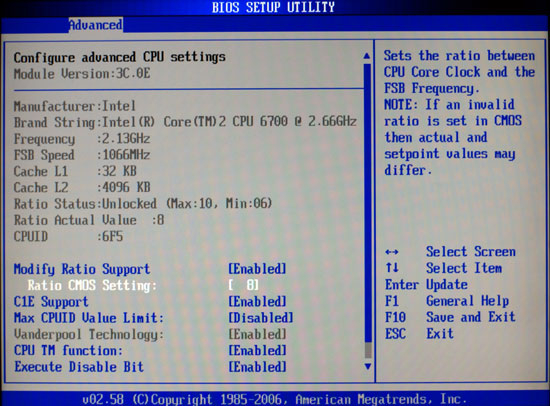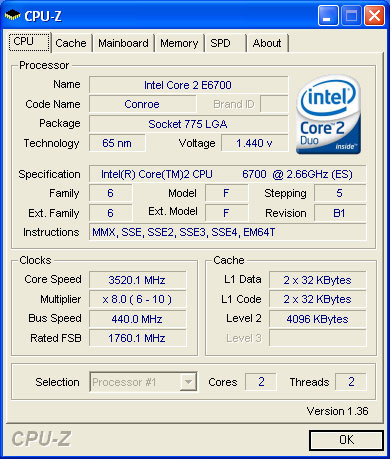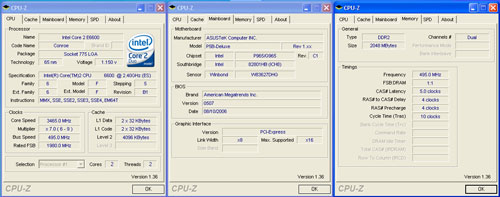ASUS P5B: New BIOS Adds Unlocking & Improved Overclocking
by Wesley Fink on August 24, 2006 3:00 PM EST- Posted in
- Motherboards
E6700
The 0507 BIOS adds a new feature in the BIOS under the "Advanced", "CPU Configuration" tab. Where there was no means to adjust CPU ratios in earlier BIOS versions, with 0507 you now have an adjustment range from 6X to 10X.

Some Conroe chips also unlock at the top, allowing ranges to about 14x. None of our Conroe chips unlocked up, but you may be one of the lucky ones who have a Conroe that unlocks both down and up.
The E6700, which runs at 2.67GHz, is very interesting because of the large headroom we consistently find at stock voltage. Once again, on the P5B Deluxe at stock voltage, the combo could run day and night at 3.4GHz (340x10) with no issues at all. At the stock multiplier of 10x, at 1.4875V the highest stable speed was 360x10 or 3.6GHz, At a reduced 9x the highest speed was 400x9, which is also 3.6GHz. With the new BIOS unlocking multipliers down, we reached 440 at 8x, or 3.52Ghz, as you can see in this screen capture.

7x allowed a further increase to a FSB speed of 494, which is where the 6700/P5B maxed out. Even at a 6X multiplier 494 seems the limit of the FSB with this CPU and board. Comparing this to our highest FSB overclock of 362 with this board in the Conroe Buying Guide we would conclude that ASUS has significantly improved the overclocking of the P5B. The ability to choose and hold lower multipliers allowed the bus speed to increase from 360 to 494.
E6600
The E6600 unlocked down with the new BIOS and allowed a new range of FSB adjustments of 405x9 (stock), 460x8, 495x7, and 495x6. Below is a screen capture at 495x7 or 3.465GHz.
While the new BIOS on the P5B adds enormous flexibility to the 965P motherboard, it should still be pointed out that on average the 965 still does not overclock as well as the Intel 975X if you compare clock to clock. You might want to look back at the 975X overclocking results in Conroe Buying Guide: Feeding the Monster for a comparison.
The 0507 BIOS adds a new feature in the BIOS under the "Advanced", "CPU Configuration" tab. Where there was no means to adjust CPU ratios in earlier BIOS versions, with 0507 you now have an adjustment range from 6X to 10X.

Some Conroe chips also unlock at the top, allowing ranges to about 14x. None of our Conroe chips unlocked up, but you may be one of the lucky ones who have a Conroe that unlocks both down and up.
The E6700, which runs at 2.67GHz, is very interesting because of the large headroom we consistently find at stock voltage. Once again, on the P5B Deluxe at stock voltage, the combo could run day and night at 3.4GHz (340x10) with no issues at all. At the stock multiplier of 10x, at 1.4875V the highest stable speed was 360x10 or 3.6GHz, At a reduced 9x the highest speed was 400x9, which is also 3.6GHz. With the new BIOS unlocking multipliers down, we reached 440 at 8x, or 3.52Ghz, as you can see in this screen capture.

7x allowed a further increase to a FSB speed of 494, which is where the 6700/P5B maxed out. Even at a 6X multiplier 494 seems the limit of the FSB with this CPU and board. Comparing this to our highest FSB overclock of 362 with this board in the Conroe Buying Guide we would conclude that ASUS has significantly improved the overclocking of the P5B. The ability to choose and hold lower multipliers allowed the bus speed to increase from 360 to 494.
E6600
The E6600 unlocked down with the new BIOS and allowed a new range of FSB adjustments of 405x9 (stock), 460x8, 495x7, and 495x6. Below is a screen capture at 495x7 or 3.465GHz.
 |
| Click to enlarge |
While the new BIOS on the P5B adds enormous flexibility to the 965P motherboard, it should still be pointed out that on average the 965 still does not overclock as well as the Intel 975X if you compare clock to clock. You might want to look back at the 975X overclocking results in Conroe Buying Guide: Feeding the Monster for a comparison.










84 Comments
View All Comments
Wesley Fink - Thursday, August 24, 2006 - link
We agree with you. We stated what we found - all Conroes we tested unlocked down. We also told you what Asus told us, but we were clear it could not be confirmed in our own testing. We did see screen shots of a locked Conroe at higher multipliers, but we did not find one in our testing. Our coverage was fair IMHO.Sunrise089 - Friday, August 25, 2006 - link
I would say the coverage was helpful, but not fair. Or if it was fair, it wasn't what I except from AT. I think normally you guys are pretty tough on campanies that don't deliver on promises, which is great because:-You're an advocate for the consumer
-You serve as a counterweight to huge manufacturer-funded marketing efforts.
I think your position on promised video-card launch dates that came and went was more what I like - you reported the manufacturer's stated date, but also blasted the GPU maker for letting the dates slip in the past and suggested it was likely to happen again.
It's fine to publish ASUS's claims, after all you want them to send you products to review, but why not editorialize a little more. Not have one chip that did what they claimed was sure plenty of justification.
Sapiens - Saturday, August 26, 2006 - link
So we should blame ASUS for the lack of Conroe chips at AnandTech that can be unlocked upwards? AT stated ASUS' claims and warned that they weren't able to verify all of them. It sounds like you just want the authors of the article to bash someone.Sunrise089 - Saturday, August 26, 2006 - link
I want the authors to keep up working on behalf of the consumer. When a company touts a feature that isn't present in many if not most cases, the company shouldn't get much credit for the "feature". Repeating the party line offered by ASUS gives them more credibility than they need to be given here. You and I can all go to ASUS's site and read up on their marketing department's list of reasons to buy their board, I expect AT to revivew the board with an eye to using their expertiese to inform me about it's strengths and weaknesses. An advertised feature that is present in ZERO percent of tested boards is more of a minus than a plus.